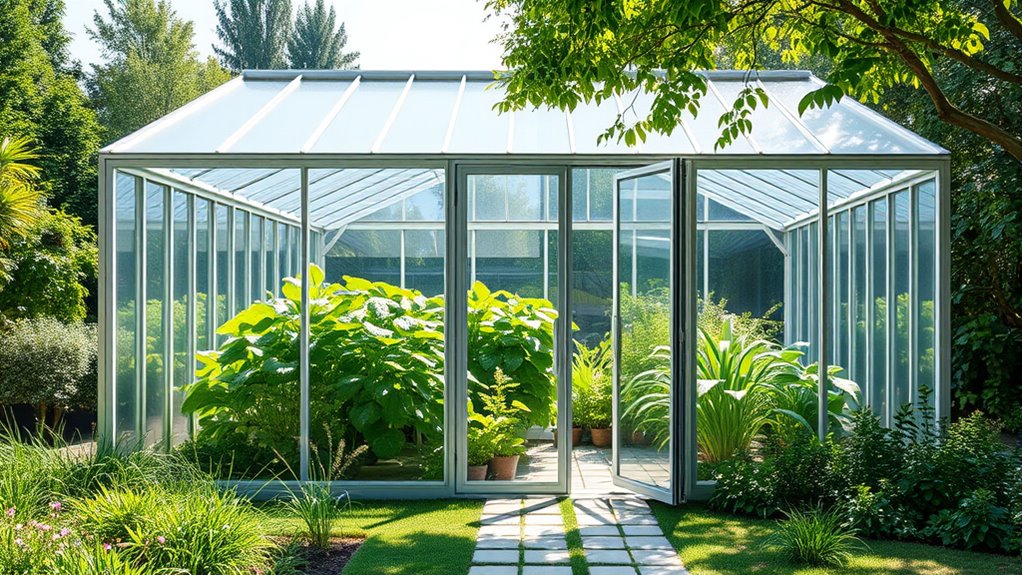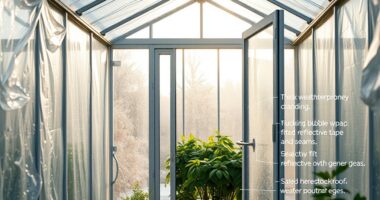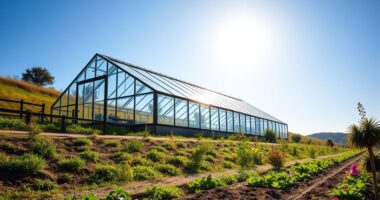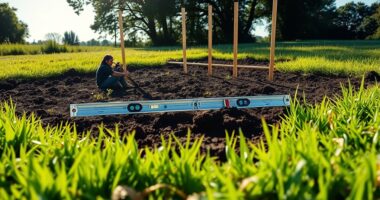Building a budget-friendly greenhouse is possible by Tacking on DIY tasks, choosing affordable yet durable materials like polycarbonate or polyethylene, and repurposing salvageable items such as reclaimed wood or old windows. Carefully compare materials for longevity and insulation, balancing upfront costs with long-term durability. Using simple construction techniques and creative reuse helps you save money without sacrificing quality. Keep exploring for practical tips to maximize your greenhouse’s value while keeping expenses low.
Key Takeaways
- Build your greenhouse yourself using online tutorials and simple tools to cut labor costs and customize design.
- Choose affordable, durable covering materials like polyethylene film or reclaimed windows to balance cost and longevity.
- Opt for cost-effective framing options such as salvaged wood or lightweight metal to reduce materials expenses.
- Incorporate recycled or repurposed materials to save money and add unique aesthetic elements.
- Research alternative materials with good insulation and UV resistance to ensure quality without high costs.

Building a greenhouse doesn’t have to break the bank. With a little creativity and some smart planning, you can create a functional, durable structure without overspending. One of the best ways to save money is by leveraging DIY techniques. By taking on some of the construction yourself, you cut down on labor costs and gain a better understanding of your greenhouse’s design. Simple projects like framing and installing panels can be manageable with basic tools and online tutorials, especially if you’re comfortable with hands-on work. Not only does this approach keep costs low, but it also gives you the flexibility to customize your greenhouse exactly how you want it.
Another essential aspect is making smart material comparisons. Instead of opting for the most expensive options, research alternative materials that offer similar durability and insulation at a lower price. For example, instead of costly glass panels, consider polycarbonate or acrylic sheets, which are lightweight, shatter-resistant, and often more affordable. When choosing framing materials, lumber can be cheaper upfront than metal, but you’ll want to compare their longevity and resistance to pests or weather. Reclaimed or salvaged wood can also be an excellent, budget-friendly option if you’re willing to put in some extra effort to select high-quality pieces.
You should also weigh the pros and cons of different covering materials. Polyethylene film, for instance, is one of the most inexpensive options for covering a DIY greenhouse. It’s lightweight and easy to install, making it ideal for a beginner project. Just keep in mind that it may need replacing every few years, but the initial savings outweigh that inconvenience. Conversely, rigid panels like polycarbonate last longer and provide better insulation, so the higher upfront cost could be justified if you’re aiming for a long-term investment. Additionally, considering the contrast ratio of your chosen materials can help ensure your greenhouse gets optimal sunlight and light diffusion, which is crucial for plant growth.
When comparing various materials, don’t forget to consider their thermal properties, UV resistance, and ease of maintenance. Cheaper materials might save you money initially but could require more frequent repairs or replacements, costing you more in the long run. Balancing cost with durability is key. Additionally, repurposing existing materials—like using recycled windows or old fencing—can considerably reduce expenses and add a unique charm to your greenhouse.
Frequently Asked Questions
How Long Does a Budget Greenhouse Typically Last?
A budget greenhouse typically lasts between 3 to 7 years, depending on materials and maintenance. Greenhouse longevity varies with the durability of the structure, so choosing sturdy, cost-effective materials helps extend its lifespan. Proper upkeep, like regular cleaning and repairs, also boosts budget greenhouse durability. While it may not last as long as high-end options, a well-built budget greenhouse still provides several seasons of productive use without breaking the bank.
What Types of Plants Thrive in Low-Cost Greenhouses?
You can grow a variety of plants in low-cost greenhouses, especially those suited for controlled environments. Focus on plant selection that thrives in high humidity and consistent temperatures, like herbs, leafy greens, and tomatoes. Keep pest management simple by using natural deterrents and proper ventilation. This approach helps you maximize your space without spending much, ensuring healthy, productive plants while keeping costs low.
Can I Build a Greenhouse Without Prior Construction Experience?
While venturing into DIY construction might seem formidable, it’s absolutely achievable for beginners. With a bit of patience and the right beginner tips, you can build a greenhouse without prior experience. Start small, follow clear instructions, and gather essential tools. Remember, every expert was once a beginner, so take your time and enjoy the learning process. Your successful greenhouse project is well within reach!
Are There Eco-Friendly Materials Suitable for Inexpensive Greenhouses?
You can definitely find eco-friendly materials for inexpensive greenhouses. Recycled plastics work well for panels or framing, offering durability and environmental benefits. Sustainable wood is another great option for framing or shelving, providing a natural, renewable resource. Both materials help you build a cost-effective greenhouse without sacrificing quality. Just make sure to select options that suit your climate and guarantee proper insulation for the best results.
How Much Maintenance Is Required for a Budget-Friendly Greenhouse?
Did you know that a well-maintained greenhouse can last up to 20 years? For your cost-effective pest control and seasonal maintenance tasks, expect to spend a few hours monthly. Regular cleaning, checking for leaks, and monitoring plants keep it efficient. You’ll save money long-term by preventing costly repairs. With consistent effort, your budget-friendly greenhouse stays productive and durable, requiring minimal upkeep while supporting healthy growth.
Conclusion
Building a greenhouse on a budget is like planting seeds for a lush future—you don’t need expensive tools to grow something incredible. With careful planning, smart choices, and a bit of creativity, you can turn simple materials into a thriving oasis. Think of your greenhouse as a sturdy vessel sailing smoothly through seasons, nurturing your plants without draining your wallet. So, roll up your sleeves and watch your budget blossom into a beautiful, fruitful haven.









